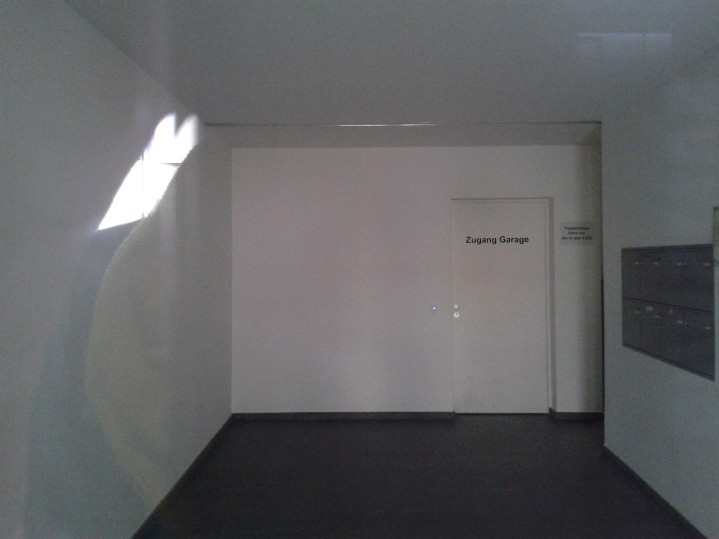I looked for St. Agnes, instead I found this
I read a Geoff Dyer short story on the bog, Skunk. I liked the style in that story, matter of fact, concise and earnest, about pretty normal stuff, like smoking skunk on the canal St. Martin. He describes looking at his dick shrimpled to just foreskin, thinking in his skunky state of mind that it’s from too much coffee. I immediately decided this was a good style to write about drab architecture, allowing quicker entries, and giving that drab architecture only the little precious time of mine it deserved.
Berlin Wu Yi academy was closed, my Taichi lesson not on. Instead of the usual route, I decided it was time to check out this St. Agnes church round my studio’s neighborhood that people were talking about. Should be easy to spot, it had a church tower. Instead, cycling up Alte Jakobstraße, I found this across from Medelsohns IG Metal buidling, adjacent to the patent office.
Looks like Zvi Häcker, I thought. He had done a building in a part of the former death strip behind the Bundesdruckerei. I remember shaking my head in sympathy that a guy like that had to do stuff like this now. It was a tack render box with some applique horizontal strips of bent metal. So was this. Nicely done, in a way. Half scale autobahn guide rails wiggly bent in strips to yield an undulating, sculptural effect that loosely mimicked the protruding Gründerzeit ornamentation of some of the neighboring buidings. The rails were out of imitation titanium looking stuff, not galvanized alu, as the real things are. It seemed to work, formally. The stuff underneath looks a bit cheap, but what can you do, this is our material reality.
That’s a bit abrupt, I thought, pressing my nose against a sheet of glass, looking straight into the drab housing entrance. The only visible features were a dry riser, a surveillance eye and a parking garage door labeled as such. What happened to architectural foreplay, or some public private gradient, like a mezzanine half story, a front step, or a court, foyer, an inviting vestibule? Can’t blame the architect, working with these constraints, cramming in as much sellable space as possible, probably scraping a living – and it’ll do for the average “metropolist”. Nobody seems to care about this stuff. Maybe in Hamburg they care, where they’re defending a decrepit building from being replaced by something like this, or worse, I think.
Metropolist. Where did that come from? Oh yeah, I looked up the building on the internet, thinking I’d confirm my cunning eye, and the bent metal bands as Zvi Hecker applique. But I was wrong. An established search engine took me straight to the marketing video of the two architects behind the Metropolenhäuser. Set to some lofty two finger piano music, the architects brood over the future of this new quarter from their white loftspace, incidently overlooking my daughter’s Kita, and John Hedjuk’s Charlottenstraße tower in the background. I’d seen Mr Muffert pull out of his garage in a Merc SLS, I think. With ominous rolling hand gestures, they prophesyze across the unsuspecting neigborhood beneath the past dynamism of Prenzlauer Berg and Mitte turn of the century, taking care to give buzz words the correct emphasis. The rest is incredibly cliche. Here’s a link if you have a masochist penchant for these things.
To sum up the project’s marketing spiel:
a building that “flirts” with the city with its large window panes, a lively neighborhood with big city flair close to the shopping paradise Friedrichstraße, in the “heart of the Southern Friedrichstadt”, Holocaust (mostly, Jewish Museum), “Topography of Terror”, Cold War (Checkpoint Charly) living excitement, and for extra spice, there are the adjacent “capricious-whimsical” (quirlig) neighborhoods, which to me seems to carry some weird diminuitive undertones of the inhabitants of the mixed neigborhoods, as in not as sobre, collected and rational as us Metropolists, qualities that have put us into positions to purchase flats from you city people, but I’m starting to think I’m way too critical.
The architects are BF studio, founded by Benita Braun Feldweg and Matthias Muffert, part of a consortium administering the bequest of Wilhelm Braun Feldweg, grandfather of Benita and a pioneering German product designer and initiator of the grant or award under his name for critical design writing. Reading Benita Braun-Feldweg’s interview on the prize, I found it hard to put what she was saying there, and the really rather vacuous marketing babble of the Metropolenhaus, together:
“The social significance of design critique is huge. As an architect I’m sorry to say that I have to state that in Germany there is no critique of architecture.[…] But a socio-political examination of content, form and necessities is nowhere to be found. Should one chose not to conform, that is to say write without seeking merely to create marketing or PR, and even take up a critical stance, this would pose a great risk for a medium that wants to maintain its circulation figures.”
Muffert and Braun-Feldweg are also the developers of the project.
Found St.Agnes, tucked away behind some 60s housing blocks, the second stop on my little tour of the new Southern Friedrichstadt.


